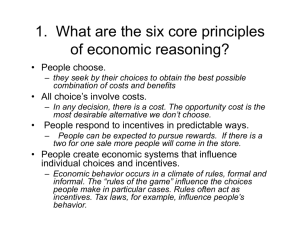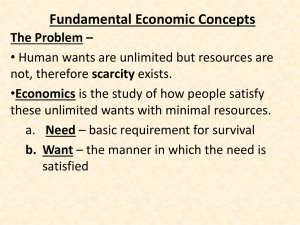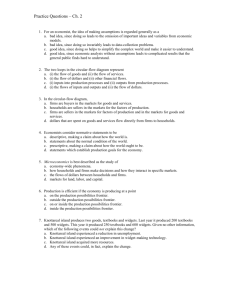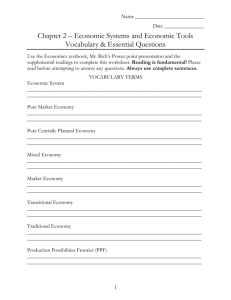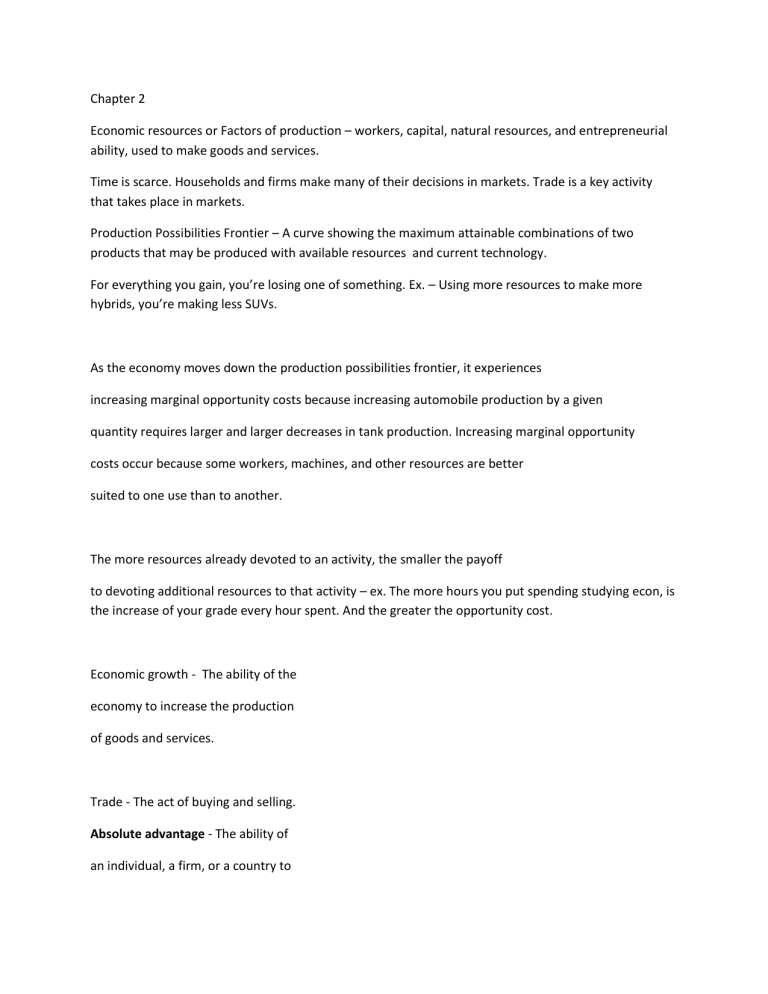
Chapter 2 Economic resources or Factors of production – workers, capital, natural resources, and entrepreneurial ability, used to make goods and services. Time is scarce. Households and firms make many of their decisions in markets. Trade is a key activity that takes place in markets. Production Possibilities Frontier – A curve showing the maximum attainable combinations of two products that may be produced with available resources and current technology. For everything you gain, you’re losing one of something. Ex. – Using more resources to make more hybrids, you’re making less SUVs. As the economy moves down the production possibilities frontier, it experiences increasing marginal opportunity costs because increasing automobile production by a given quantity requires larger and larger decreases in tank production. Increasing marginal opportunity costs occur because some workers, machines, and other resources are better suited to one use than to another. The more resources already devoted to an activity, the smaller the payoff to devoting additional resources to that activity – ex. The more hours you put spending studying econ, is the increase of your grade every hour spent. And the greater the opportunity cost. Economic growth - The ability of the economy to increase the production of goods and services. Trade - The act of buying and selling. Absolute advantage - The ability of an individual, a firm, or a country to produce more of a good or service than competitors, using the same amount of resources. Comparative advantage. - The ability of an individual, a firm, or a country to produce a good or service at a lower opportunity cost than competitors. In our example, your neighbor has a comparative advantage in picking cherries, but you have a comparative advantage in picking apples. Market - A group of buyers and sellers of a good or service and the institution or arrangement by which they come together to trade. Product market - A market for goods—such as computers—or services—such as medical treatment. Factor market - A market for the factors of production, such as labor, capital, natural resources, and entrepreneurial ability Factors of production - The inputs used to make goods and services. Circular-flow diagram - A model that illustrates how participants in markets are linked. Free market - A market with few government restrictions on how a good or service can be produced or sold or on how a factor of production can be employed. Households supply labor and other factors of production in exchange for wages and other payments from firms. In product markets, households use the payments they earn in factor markets to purchase the goods and services supplied by firms. Firms produce these goods and services using the factors of production supplied by households. Property rights - The rights individuals or firms have to the exclusive use of their property, including the right to buy or sell it Question 1 0 out of 4 points Figure 2-4 Figure 2-4 shows various points on three different production possibilities frontiers for a nation. Refer to Figure 2-4. Consider the following events: Which of the events listed above could cause a movement from V to W ? Correct Answer: a only Question 2 4 out of 4 points In economics, choices must be made because we live in a world of Correct Answer: scarcity. Question 3 4 out of 4 points A production possibilities frontier with a bowed outward shape indicates Correct Answer: increasing opportunity costs as more and more of one good is produced. Question 4 4 out of 4 points The production possibilities frontier shows the ________ combinations of two products that may be produced in a particular time period with available resources. Correct Answer: maximum attainable Question 5 4 out of 4 points Markets promote Correct Answer: competition and voluntary exchange. Question 6 4 out of 4 points Economists assume that rational people do all of the following except Correct Answer: undertake activities that benefit others and hurt themselves. Question 7 0 out of 4 points Households Correct Answer: sell resources in the factor market. Question 8 4 out of 4 points Scarcity Correct Answer: stems from the incompatibility between limited resources and unlimited wants. Question 9 0 out of 4 points Figure 2-4 Figure 2-4 shows various points on three different production possibilities frontiers for a nation. Refer to Figure 2-4. Consider the following events: Which of the events listed above could cause a movement from Y to W ? Correct Answer: c only Question 10 4 out of 4 points Figure 2-4 Figure 2-4 shows various points on three different production possibilities frontiers for a nation. Refer to Figure 2-4. Consider the following movements: Which of the movements listed above represents economic growth? Correct Answer: b and c only Question 11 4 out of 4 points The slope of a production possibilities frontier Correct Answer: measures the opportunity cost of producing one more unit of a good. Question 12 4 out of 4 points Adam Smith's invisible hand refers to Correct Answer: the process by which individuals acting in their own self-interest bring about a market outcome that benefits society as a whole. Question 13 0 out of 4 points Figure 2-5 Refer to Figure 2-5. If the economy is currently producing at point W, what is the opportunity cost of moving to point X? Correct Answer: 5 million tons of paper Question 14 4 out of 4 points An example of a factor of production is Correct Answer: a worker hired by Dell. Question 15 0 out of 4 points Figure 2-2 Figure 2-2 above shows the production possibilities frontier for Mendonca, an agrarian nation that produces two goods, meat and vegetables. Refer to Figure 2-2. Suppose Mendonca is currently producing 60 pounds of vegetables per period. How much meat is it also producing, assuming that resources are fully utilized? Correct Answer: 75 pounds of meat Question 16 4 out of 4 points The basic economic problem of ________ has always existed and will continue to exist. Correct Answer: scarcity Question 17 4 out of 4 points The principle of opportunity cost is that Correct Answer: the economic cost of using a factor of production is the alternative use of that factor that is given up. Question 18 0 out of 4 points In the circular flow model, producers Correct Answer: hire resources sold by households in the factor market. Question 19 4 out of 4 points All of the following are part of an economic model except Correct Answer: opinions. Question 20 0 out of 4 points Figure 2-4 Figure 2-4 shows various points on three different production possibilities frontiers for a nation. Refer to Figure 2-4. A movement from Y to Z Correct Answer: is the result of advancements in plastic production technology. Question 21 4 out of 4 points The production possibilities frontier model shows that Correct Answer: if all resources are fully and efficiently utilized, more of one good can be produced only by producing less of another good. Question 22 0 out of 4 points Figure 2-4 Figure 2-4 shows various points on three different production possibilities frontiers for a nation. Refer to Figure 2-4. Consider the following events: Which of the events listed above could cause a movement from W to V? Correct Answer: a and c only Question 23 4 out of 4 points Economists assume that rational behavior is useful in explaining choices people make Correct Answer: even though people may not behave rationally all the time. Question 24 4 out of 4 points Economic models do all of the following except Correct Answer: portray reality in all its minute details. Question 25 4 out of 4 points Which of the following is a normative economic statement? Correct Answer: The price of gasoline is too high. Tuesday, January 20, 2015 8:04:35 PM EST

